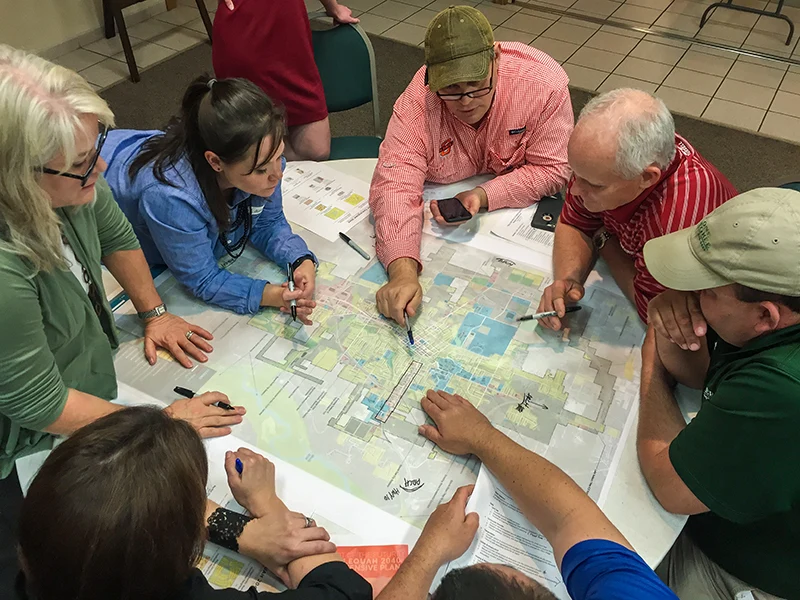
Crafton Tull
Since 1963There's not much debate about the value of public participation in the community planning world. Whether it's a comprehensive plan, a downtown master plan, or a corridor plan, one of the most crucial elements to these efforts is the interaction with an engaged and informed body of residents. Active participation from the public leads to better planning decisions and creates a sense of ownership moving forward. But how do we achieve effective community engagement? What can planners do to give all community stakeholders a voice while ensuring their input is actionable? Communities often struggle to provide answers to these questions. This struggle is one of the reasons why some public meetings have poor attendance, and key stakeholders are left on the outside, looking in.
There is no such thing as an exhaustive list of community engagement strategies that guarantee success. Each city requires a tailored public participation plan that takes into account its unique social fabric. However, some strategies apply to all communities and, if executed correctly, foster authentic civic engagement.
Below are five strategies for communities to consider for their next planning project:
Change-up the traditional public meeting
The traditional “come but only listen” public meeting doesn’t quite drum up feelings of excitement. While some stakeholders might prefer the traditional public meeting format, this approach could alienate a vital portion of the community if they are not given the chance to provide input. Additionally, by holding meetings exclusively at city hall, planners set the expectation that citizens need to come to them instead of encouraging an open two-way dialogue.
Try hosting meetings in places that are kid-friendly so families can attend or set up an area with an activity to allow children to provide input on their level of understanding. Be sure the facility is easily accessible and inviting. Host meetings in different locations to encourage attendance by a variety of user groups and consider whether or not there is a language barrier. Does your community have a large population of non-English speakers? If so, you may need to have an interpreter at your meeting.
It’s also important to make sure your meeting does not compete with popular community events. If possible, avoid meal time conflicts. If a meeting must be held during a meal time window, consider providing food or holding the meeting at a restaurant large enough to accommodate the potential number of attendees.
Doing it wrong: “Public meeting to be held at city hall. No kids allowed. Water fountain available.”
Doing it right: “Coffee & doughnuts with staff and stakeholders at the public library to discuss our future.”
Provide autonomy
Listening is only part of public engagement. Residents need to know that their input plays a direct role in plan outcomes. To achieve authentic engagement that derives from a real need in the community, planners and city leadership need to provide a certain degree of autonomy to the public. Planners must continually show how publicly-sourced ideas and feedback fit into the decision-making process. If residents feel like a public meeting is just for show, expect poor attendance at subsequent meetings and pushback when it's time for plan adoption.
Doing it wrong: “Submit comments, we might read them.”
Doing it right: “Thank you! Survey results are online and printed copies are available at city hall and the public library.”

Communicate directly
Once you have scheduled your next public meeting, how do you get the word out? Social media is powerful and free to use, making it a popular and worthwhile option. Local media outlets can help spread a message. Chambers of commerce and professional organizations have large circles of influence. While these methods are effective in reaching people, direct city-to-resident communication is essential. Direct communication can be achieved through email or text message if a city maintains a subscriber list. Printed direct mail can be a viable option if a city is already sending utility bills. While all of these methods are effective, none of them are powerful enough on their own. Leverage all communication channels to draw a diverse group of people to events and increase participation.
Doing it wrong: “We only posted it to our 30 Twitter followers. We did our best.”
Doing it right: “We utilized social media AND spoke in person with 50 business owners as well as their customers.”
Educate
An informed public with knowledge of community development best practices is an asset to any planning project. Sometimes referred to as "citizen planners," these individuals can elevate a planning effort by combining their first-hand community insight with their understanding of planning and development regulations. They can help bring consensus to sound ideas by speaking as a member of the community rather than as an outsider. They can also act as project “champions” during implementation phases to follow.
There are many ways to cultivate citizen planners. Some communities use public forums featuring subject-matter experts as a way to educate interested parties. Walkshops are another type of event where attendees view real-world problems and potential solutions firsthand at ground-level. Educational materials such as articles from the American Planning Association (APA) can build consensus around topics not commonly addressed at planning meetings. All of these combined efforts will create a cohort of informed community members that will benefit future planning initiatives.
Doing it wrong: “It’s technical, you might not understand.”
Doing it right: “Here are some articles and case studies from other cities doing the same thing.”

Stay transparent and accessible
It is crucial to clearly and honestly report planning successes as well as ongoing challenges to the public. If you exclude members of the community from the dialogue, it can get ugly. As planners, we must be approachable, fair, trusted advisors. One way to earn trust is through honest communication with the public. Publish progress updates on the city website and display printed materials in a public place to make the information easily accessible.
Doing it wrong: “We’re only required to notify residents within 300 feet.”
Doing it right: “Project documents are available on the website [link] and in person at city hall.”

Public engagement is essential to any planning exercise, big or small. The value of public involvement during the planning process is not about the number of people in the room, but about understanding the tone, content, and appetite for change among all participants. An experienced and passionate planning team that understands how to maximize community engagement is vital to project success. Each community is diverse and unique and will require a tailor-made engagement process. In total, these strategies will enhance the quality of public engagement and put your team on a path to success.